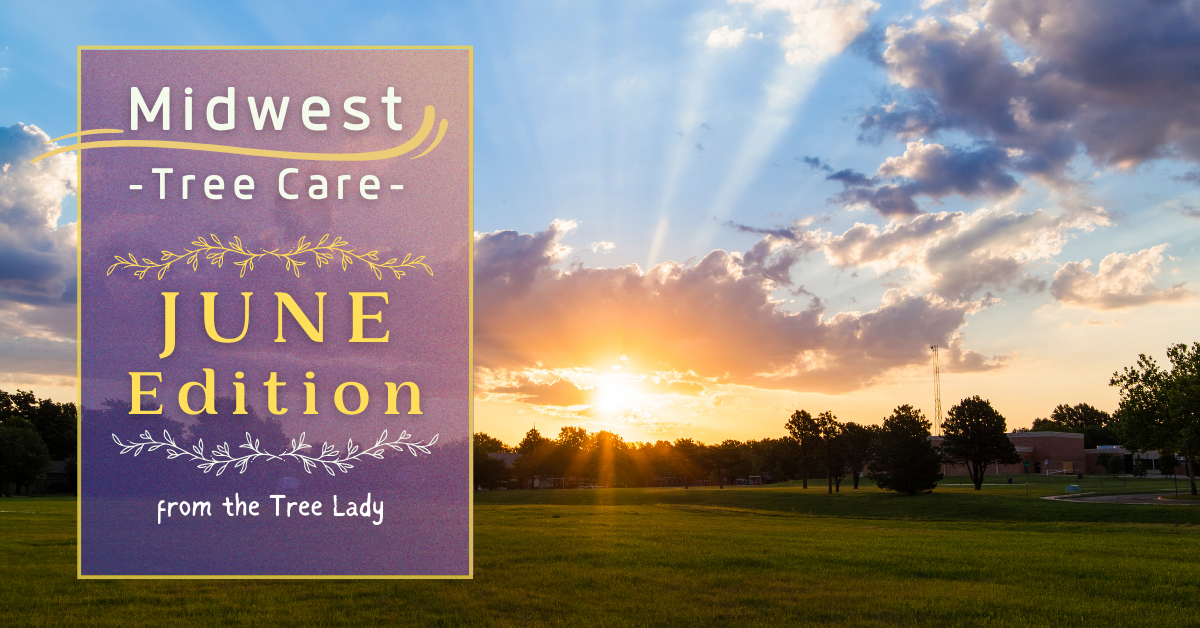JUNE Tree Topics | Bagworms, Pine Pruning & More!
As the summer heats up, it's important to stay on top of tree care to ensure healthy growth and prevent damage from storms and lawn care equipment. In this month's article, we'll cover essential tips for bagworm treatment, pine tree pruning, and preparing your trees for storm season. Read on to learn how to keep your trees thriving all summer long.
DAMAGE CONTROL
Install mulch or tree cage to prevent damage from lawn equipment.
As Omaha residents fire up their lawnmowers & weed eaters, incidences of bark & cambium damage are on the rise. Believe it or not, enough damage to the bark can kill your tree. It's easy to tell if your tree is being damaged by lawnmowers. You can see stripped bark & white tissue near ground level. Scars from previous mowing/growing seasons may also be present.
There are things you can do to protect your trees. If you are the main landscaper, the fix may be as simple as exercising more caution when using lawn care equipment. If you hire a lawn care service, or have kids that are just learning to do work, you may consider installing an additional buffer.
Mulching can help prevent damage from lawnmowers & weed eaters by creating distance between the lawn & base of the tree. If your lawn care specialist or kids still aren't taking the hint, despite mulching, you can create a physical barrier by installing a tree cage instead of, or in addition to, mulching. We recommend mulching, whether or not you install a tree cage, as it mimics the normal leaf litter layer of the forest floor and provides so many benefits for your tree!
PINE PRUNING
Prune pine candles by half when they have finished elongating.
We all LOVE a good, bushy pine tree, but when they begin encroaching on homes, walkways, streets, and other trees & landscaping, it causes complications (sticky, pokey complications!). If you could go back in time, you would take that sprig you planted and move it over 10 feet. Unfortunately, hindsights 20/20. Fortunately, there is a way to pull the reigns a little. You can control the growth rate through regular pruning of your pine tree. Prune pines when their candles have finished elongating. Once the candles flip up on the ends of the branches, you can cut the candles in half. It won't help you go back in time, but it may give you time before your tree becomes an issue.
Next time you plant, we know you will give more weight to mature size & proper placement. If you are feeling nervous about it, consult with your nursery or a qualified Nebraska Arborist.
STORM SEASON
Inspect & prune trees before storm season sets in Omaha.
In our last article, we mentioned that it is now time to prune most deciduous trees (Exceptions include species prone to certain pests and diseases. They should be pruned before bud break). Now, we give you the same advice, but put a timer on it! Have your trees inspected, trimmed & pruned before high winds & storm season set in. A qualified arborist can inspect the tree for abnormalities, weak spots, prior damage & hazardous dead wood. We consider hazardous dead wood to be branches the thickness of a pop can or larger (2" diameter). While dead wood doesn't necessarily affect the health of the tree, it does pose a risk for home & human health. A little bit of maintenance goes a long way in protecting the safety of your family.
BAGWORMS
Check for bagworms, assess, & treat severe infestations before the end of the month.
Bagworms hatch late-May to mid-June. A bagworm will make a host out of nearly anything! They feed on all kinds of trees, shrubs & perennials. Trees that lose & regrow leaves every year are rarely decimated, but for evergreens, a bagworm infestation can spell death.
As many as 1000 small brown & tan caterpillars with black markings may emerge from one bag. The bag is green or brown in color, and can reach up to 2in. The cocoon is made of needles and leaves from its host plant, which acts as camouflage. As larvae emerge, they spin a small strand of silk , which allows them to repel to other branches or ride the wind to other nearby hosts.
Once the larvae land on a viable host, they begin building small bags for themselves. As larva feed & grow, so do their bags. By the end of the summer, the larva slow their feeding & prepare to pupate. In August, they securely attach their completed bag to a twig using strong silk and crawl inside. In September, winged males emerge and seek out a mate. Flightless females remain in their bags, where she will lay her eggs for next years population of bagworms.
Since females cannot fly, local populations can quickly grow out of control, decimating the urban forest around them. The most environmentally friendly way to control small populations is to manually pluck and destroy the bags.Thoroughly squish or burn bags. Take no survivors!
If the infestation has simply gotten out of hand (it's okay, it happens to the best of us!), you can apply insecticide in June, while caterpillars are still young. Treatment becomes less effective as larva mature, so act now! You can find bagworm insecticide in Omaha at home & garden stores. For this intervention to work, the caterpillars must feed on the insecticide, so it is critical that you coat the entire plant. I'm not sure if it's the licensed chemical applicator or the mom inside of me saying this, but be sure to completely read the label before you begin and use appropriate PPE!
Tree To-dos: Don't Forget!
If you missed our last article, here are the topics that are still relevant this month. Pay attention to timelines, as the window of opportunity for these tasks may be closing soon!
PRUNE LILACS
If you have not already done so, consider pruning your Lilacs to improve flowering next year. Aim to prune as flowers wither. If you wait too long, it will actually reduce blooms next year. See our May article for more information on this topic and for instructions on proper pruning technique.
EAB INJECTIONS
Emerald Ash Borer treatments begin this month. The treatment window is short, so you needed to be on the schedule already for this season. If you missed the opportunity for treatment, you can still schedule an assessment with the goal of getting on the books for next spring.
Questions? Ask A Nebraska Arborist
Ask your question here or request a free 30-min in-person consultation! As one of Omaha’s original tree services, we care deeply about our community and the success of their trees. We are here as a resource for tree care in Omaha and the surrounding area.

